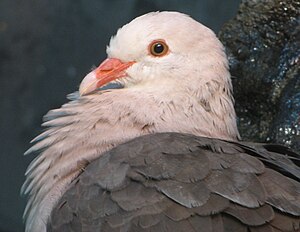Rose pigeon
| Rose pigeon | ||||||||||
|---|---|---|---|---|---|---|---|---|---|---|

Rose pigeon ( Nesoenas mayeri ) |
||||||||||
| Systematics | ||||||||||
|
||||||||||
| Scientific name | ||||||||||
| Nesoenas mayeri | ||||||||||
| ( Prevost , 1843) |
The pink pigeon ( Nesoenas mayeri ), even pink pigeon , Mauritius Pink Pigeon or short Mauritius pigeon called, is a rare, on Mauritius endemic pigeons art .
features
The rose pigeon reaches a length of 36 to 38 centimeters and weighs 320 to 350 grams. Her neck is of medium length, her head is small and round. The wings are dark gray to dark brown, the primaries are a bit darker. The fan-shaped tail is red-brown. The rest of the plumage is pale pink in color. The strong and slightly thickened beak has a light red base and a white to pale pink tip. The bright red feet have one short and three long toes with strong claws. The eyes are surrounded by a red, featherless lid ring, the iris is dark yellow in color.
Way of life and distribution
The rose pigeon eats leaves, fruits , flowers, seeds, and buds from both native and introduced plants. The females of the species call briefly and nasally hoo hoo , males coo loudly cooo . The nest consists of twigs and is erected by both sexes in the branches of a tree. The female usually lays two eggs.
The rose pigeon is only found in the south of Mauritius , an island in the Indian Ocean , and on the Ile aux Aigrettes , which is just off the east coast .
Protection and continuance
The main threats are the clearing of forests and the animal species introduced by humans such as the black rat , Indian mongoose , house cat and crab monkey . Heavy storms can also decimate the rose pigeon population. In 1960, 1975 and 1979 about half of all rose pigeons perished in hurricanes. There is no danger from the native populations of the islands, as they believe that the rose pigeon occasionally eats the fruits of the poisonous fangame tree.
As early as 1830 the stock was classified as critical . More accurate counts were made later. In 1991 the number of birds had dropped to 10 specimens. Rose pigeons were first kept in captivity around 1970, in Mauritius and in the Jersey Zoo on the island of Jersey . Further breeding groups were founded in zoos, the Walsrode bird park is noteworthy . Today around 150 birds live in zoos. In 2001 there were again 350 specimens (in five populations ) in the wild after abandoning animals hatched in captivity.
Systematics
The rose pigeon was formerly classified as Columba mayeri in the genus of field pigeons and later placed in its own genus Nesoenas . Recent studies, including DNA , however, analyzes showed that the closest related type the Malagasy Turtle Dove ( Streptopelia picturata ) is, whereupon the pink pigeon, 2001 in the genre of turtledoves presented. In 2005, however, it was separated back into the genus Nesoenas together with the Madagascar turtledove .
The Réunion rose pigeon ( Nesoenas mayeri duboisi ) Rothschild , 1907, which became extinct around 1700 and was only found on the island of Réunion , is regarded as a subspecies of the rose pigeon.
Individual evidence
- ↑ Kevin P. Johnson, Selvino de Kort, Karen Dinwoodey, AC Mateman, Carel ten Cate, CM Lessells & Dale H. Clayton: A molecular phylogeny of the dove genera Streptopelia and Columba . Auk, 118, 4 pp. 874-887, 2001 doi : 10.1642 / 0004-8038 (2001) 118 [0874: AMPOTD] 2.0.CO; 2 PDF
- ^ Anthony S. Cheke: Naming segregates from the Columba – Streptopelia pigeons following DNA studies on phylogeny. Bulletin of the British Ornithologists' Club (BOC), 125, 4, pp. 293-295, 2005
- ^ IOC World Bird List Pigeons
literature
- David Burnie: Animals. The great picture encyclopedia. Dorling Kindersley Verlag GmbH, Munich 2001, ISBN 3831002029 .
Web links
- Videos, photos and sound recordings of Nesoenas mayeri in the Internet Bird Collection
- description
- Birdlife international
- Avibase
- Nesoenas mayeri inthe IUCN 2013 Red List of Threatened Species . Listed by: BirdLife International, 2012. Retrieved January 4, 2014.

